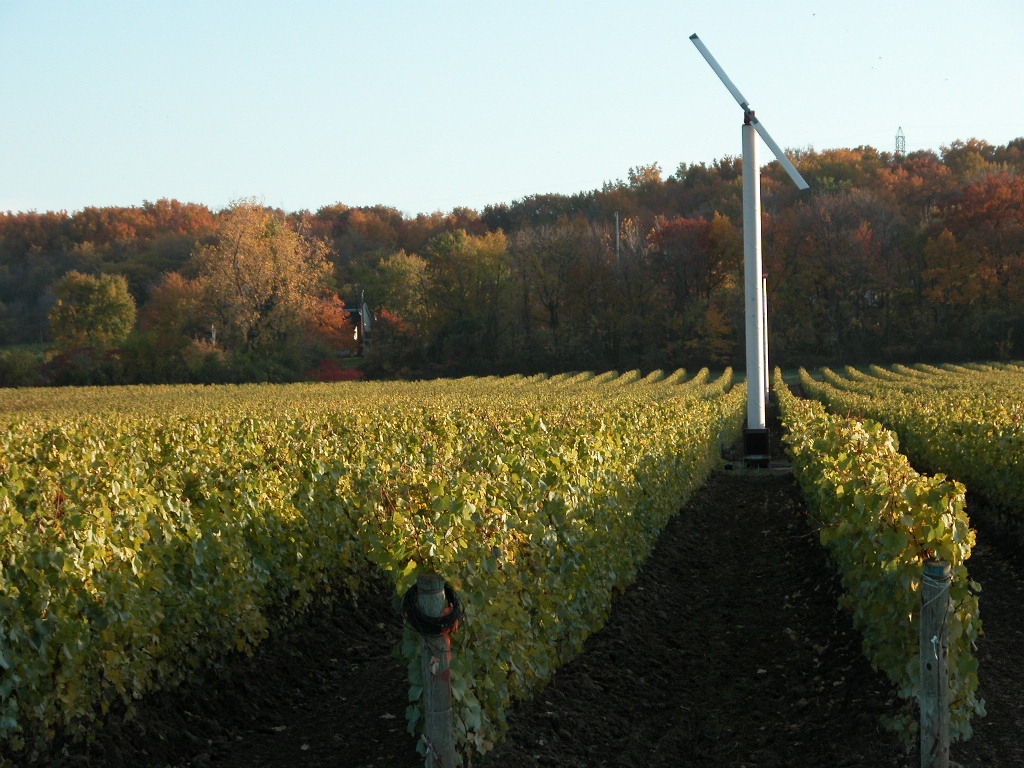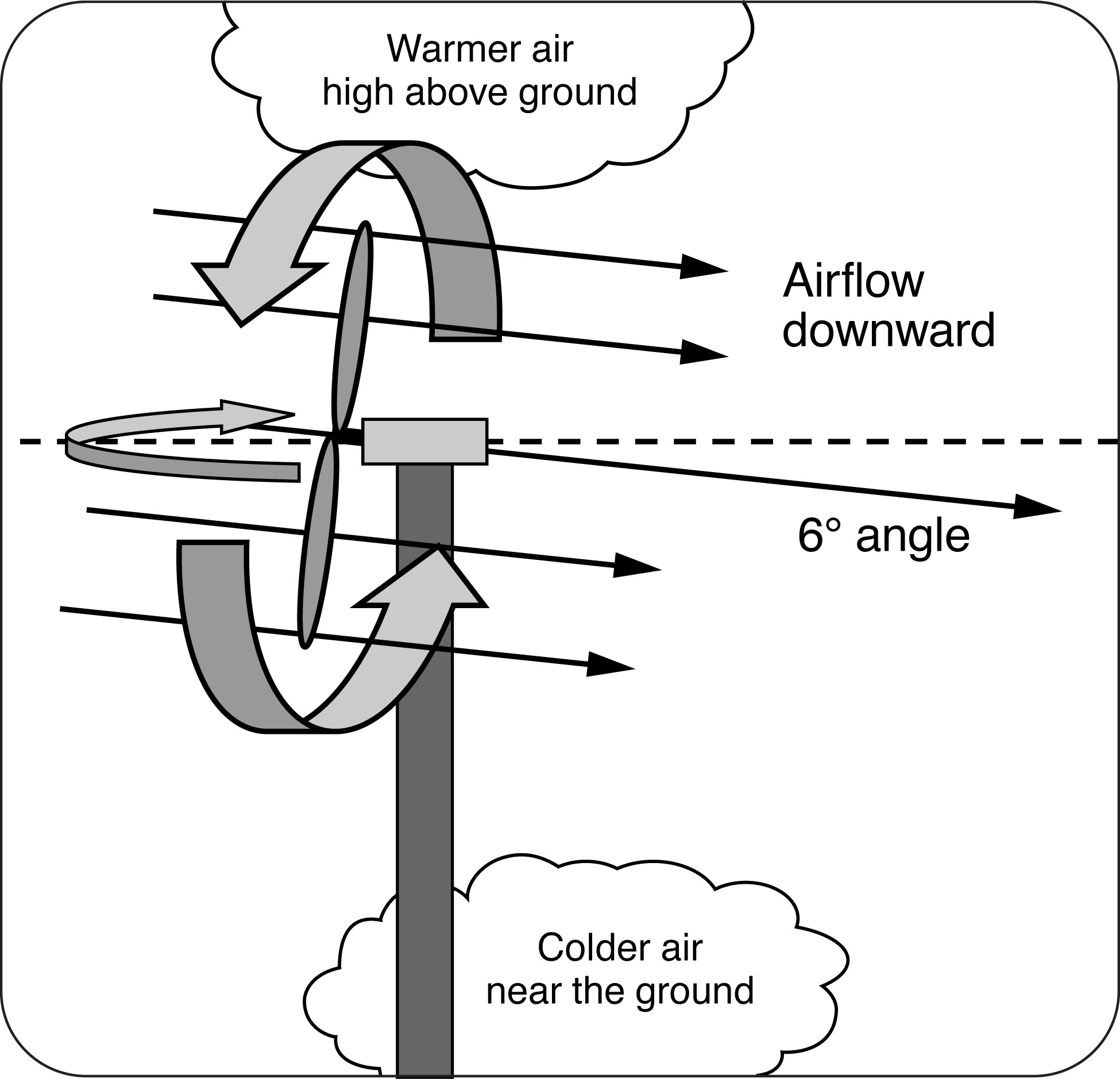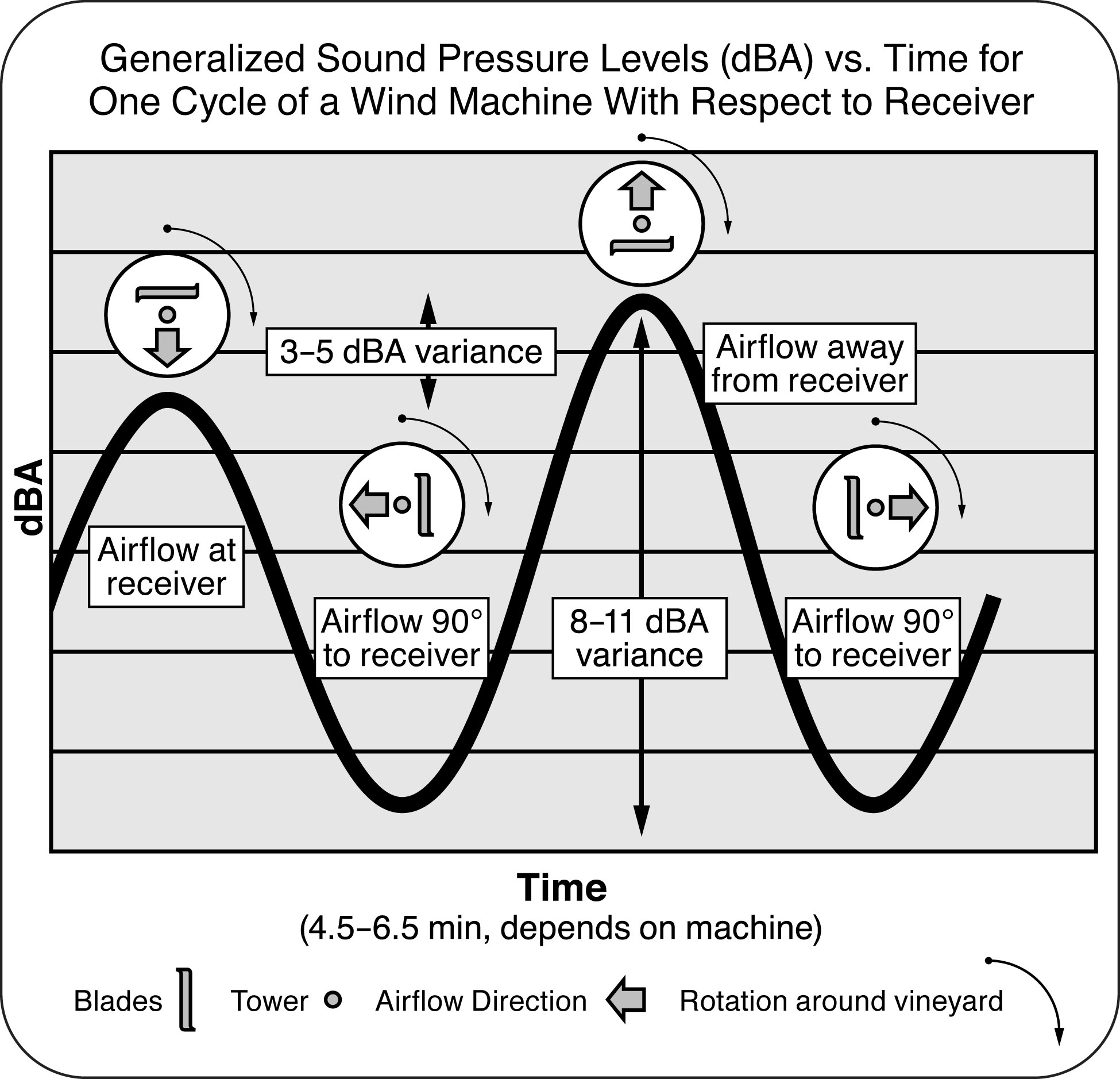Wind machines for minimizing cold injury to horticultural crops
Learn how to use wind machines to protect grapevines and tender tree fruits from cold temperatures. This technical information is for commercial fruit growers in Ontario.
ISSN 1198-712X, Published June 2010
Introduction
When plant tissue temperatures fall below critical values, sensitive perennial crops such as grapevines and tender tree fruits can suffer irreversible cold injury, causing malfunction or death of plant cells.
One protection method is to use wind machines, which became widely used in Niagara for grapes in the late 1990s. Today there are almost 500 wind machines in Ontario.
A four-year, on-farm research project conducted in Niagara to establish best management practices for wind machines and find more effective ways to use them ended in fall 2009.
Wind machine operation
Wind machines are tall, fixed-in-place, engine-driven fans that pull warm air down from at least 15 m above ground during strong temperature inversions, blowing it down and out, pushing away and replacing cold air near target crops. This raises air temperatures around cold-sensitive perennial crops such as grapes (Figure 1). Wind machines are not the same as wind turbines, designed to create electricity from wind energy.

Wind machines break up micro-scale air boundary layers over plant surfaces, improving sensible heat transfer from the air to the plants. Wind machines transfer heat by forced convection. While the blades spin, the head of the fan rotates around the tower’s vertical axis. Air circulates north, east, south, west, then north again 4.5–6.5 min later, depending on the machine type (Figure 2). The area protected covers 3–5 ha, depending on topography, field layout, strength of temperature inversion, time of year and drift due to slight winds.
If a wind machine completes this circuit too slowly, cold air can resettle or drift in from cooler areas upstream or upwind of the machine, resulting in crop injury. It doesn’t take long for crop damage to occur at critical air temperatures.

Temperature inversions
Temperature inversions are strong when air temperatures 20 metres above the field are at least 3˚C warmer than at crop level — about 0.625 m above ground. Strong, night-time radiative temperature inversions occur during periods when wind machines might be used in Niagara when skies are clear and starlit, but with minimal wind movement. Temperature inversions of up to 10˚C were observed during the research project.
For inversions to form, wind speeds must be less than 7 km/h; for inversions to break up, wind speeds must be greater than 7 km/h. This is because the wind mixes the air above the field with the air at ground level. This is like a house furnace fan mixing air throughout a house to keep air temperatures more uniform. When that fan is off, air stratification can occur with colder, heavier air settling in the basement, while warmer, lighter air rises and remains upstairs. Wind machines can raise air temperatures around plants by about a third to half the temperature inversion difference.
Field air temperatures are often very different from local or regional forecasts. Forecasts don’t predict air temperatures close to crop levels or low areas where air temperatures are often colder. Air temperatures can drop abruptly many degrees in an hour, often at sunset or sunrise, so predicting exactly if and when to operate a wind machine can be difficult.
Effects on air temperatures near the ground
The effect on air temperatures near the ground is almost instantaneous after a wind machine is turned on, but air temperatures will vary slightly throughout the area. See Table 1. Note a strong temperature inversion of 4.8°C at 2:25 am just as the wind machine started (6.2–1.4 = 4.8°C), while air temperatures 20 metres above the vineyard remained almost constant, indicating what might be considered an ocean of warm air high above the field.
| Time of day (am) | Wind machine status | Air temperatures 20 m above vineyard | Air temperatures at vine level 115 m north of wind machine |
|---|---|---|---|
| 2:20 | Off | 6.1°C | 1.5°C |
| 2:25 | Started | 6.2°C | 1.4°C |
| 2:30 | On | 6.1°C | 1.5°C |
| 2:35 | On | 5.8°C | 1.7°C |
| 2:40 | On | 5.8°C | 2.0°C |
| 2:45 | On | 6.1°C | 2.2°C |
| 2:50 | On | 6.0°C | 2.5°C |
There was a slight 4–5 km/h southwesterly wind causing air temperatures to rise higher on the northeast (downstream) side of the wind machine, while air temperatures rose more slowly on the southwest (upstream) side of the wind machine. The area protected by a wind machine is affected both by topography and by wind direction and speed, since cold air flows down slope like cold molasses.
Noise from wind machines
Many neighbours do not like wind machine noise. Machines need large engines operating at high RPM and long-pitched blades to blow air a long distance, so it is difficult to design them to be quieter. Sound comes from the engine and the blades. Because wind machines make a 360˚ sweep around the tower over a few minutes, sound oscillates in intensity in a sinusoidal fashion. Some find this irritating, since it makes them wait in anticipation for the sound to grow louder (Figure 3).

Slower blade speed reduces noise, but reduces airflow, so more machines are needed to cover the same area.
Unfortunately, it is generally very quiet in rural areas at times when wind machines operate during the spring, fall or winter nights when there are few, if any, other noises, such as wind or cars, to mask the sound. Conditions outside also complicate and affect sound movement from wind machines by:
- lack of grape vegetation, grass on ground or leaves in woodlots to muffle sounds
- bouncing of sound waves off the warmer, temperature inversion layer high above ground
- hard, frozen, non-absorbing winter ground surfaces for sound waves to travel across
- source of sound being very high above ground, allowing it to travel greater distances
- simultaneous operation of multiple machines
- low relative humidity of the cold air
Conditions inside homes that complicate and allow external sound waves to penetrate or be amplified include large rooms, large windows, hard floors and light construction.
Wind machine sound is generally quieter and less offensive in small carpeted rooms with heavy thick walls and in house areas opposite to the side where a wind machine is, or in basements. The sound is sometimes partially masked inside a house if there is white noise present, such as from a radio, television or ventilation fan.
Wind machine blades produce low frequency infrasound waves that travel long distances and may penetrate building components of residential structures. Low frequency sound is like low bass music sounds you might hear in your home when someone next door is playing their stereo, even though you cannot hear the rest of the music.
Normal farm practice
Farmers are protected from nuisance noise complaints by neighbours provided they follow normal farm practice. Normal farm practice can only be determined by the Normal Farm Practices Protection Board, a quasi-judicial administrative board of non-government members, appointed by the Ontario Government under the Farming and Food Production Protection Act (FFPPA).
The FFPPA, 1998, defines normal farm practice as one which:
- is conducted in a manner consistent with proper and acceptable customs/standards, as established and followed by similar agricultural operations under similar circumstances
- uses innovative technology consistent with proper advanced farm management practice
Best management practices for operation of wind machines
Grape growers should employ the following best management practices for operating wind machines to use them more effectively and minimize nuisance noise.
Crop hardiness
- Manage plants so they are as healthy as possible going into winter.
- Use the most up-to-date plant hardiness information and take into account critical plant temperatures when decisions are made to operate a wind machine.
Locate wind machines
- to account for expected skewing effects on their areas of influence by topography and wind direction
- to account for adjacent wind machines and features that might provide additional cold injury protection such as roads, warm buildings, streams or woodlots
- consider planting crops that are more sensitive to cold injury as far as practical from neighbours’ houses, so wind machines can be located further from their homes.
Monitoring
- Use the best local weather forecasts available.
- Monitor continually for strong temperature inversions, greater than 3˚C, on or near the farm to determine if operating machine(s) might provide some plant protection from cold injury. This includes a tower at least 10 m high to monitor air temperatures above the crop.
- Set start-up temperatures for wind machines based on sensors located below the fruiting wire and within 15 m of each machine.
- Monitor and automate start up/operation/shut down of wind machines, using a combination of real-time remote air temperature/wind speed/wind machine operation sensing devices and monitoring via cellphones/computers/pagers, etc.
- Set start-up air temperatures as close as practical to expected critical air temperatures:
- spring frost: 2°C–3°C
- fall frost: 1°C–2°C
- winter: variable based on latest bud hardiness data from local freezing trials
- Set the differential (wind machine stop temperature) 2°C–3°C higher on wind machines than for start-up temperatures.
Wind
- Do not operate wind machines if wind speeds are much higher than 7 km/h as there is unlikely to be a strong temperature inversion or warmer air above the field anyway.
- Do not operate wind machines if wind speeds are 13 km/h or higher, as this can damage their long, thin blades.
- Never operate wind machines if wind speeds are 21 km/h or higher, as this can seriously damage them.
Maintenance
- Maintain wind machines in good condition with annual check-ups by changing the gearbox oil (at tower base and top), lubricating drive lines and inspecting seals, checking the tension of all bolts on the tower, inspecting blades and attaching hardware, performing regular engine maintenance and keeping booster cables handy for quick use.
Noise
- Locate wind machines as far as practical from neighbouring homes within agricultural areas, but not closer than 125 metres unless best management practices are used.
- Explain to neighbours living within 125 metres of a machine how and why wind machines operate; consider creating an early warning system about possible wind machine use; give them a 24-hour cellphone number to call; set the machines closest to neighbours to be the last on and the first off.
- Be diligent operating wind machines on farms where you do not live, as you are not always there to hear if and how they operate.
- Install mufflers on all wind machines.
On-going learning
Train and educate all employees operating wind machines on the latest best management practices to minimize machine operation.
This factsheet was written by Hugh Fraser, P.Eng., (retired), Horticultural Crop Protection & Post Harvest, OMAFRA, and is a collaborative effort by research team members, Ken Slingerland (retired), tender fruit and grape specialist, OMAFRA; Kevin Ker and Ryan Brewster, KCMS Consultants, Fenwick; and Helen Fisher, grape research scientist, University of Guelph, Vineland.